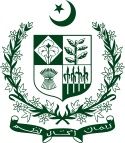| |||||||||||||||||
80,000 Basic Democrats 40,001 votes needed to win | |||||||||||||||||
|---|---|---|---|---|---|---|---|---|---|---|---|---|---|---|---|---|---|
| Turnout | 79,700 (99.63%)[1] | ||||||||||||||||
| |||||||||||||||||
 | |||||||||||||||||
| |||||||||||||||||
 |
|---|
|
|
Pakistan's first presidential elections were held on 2 January 1965. The voting was to be indirect, as the President had to be elected by the 80,000 "basic democrats", who made up the Electoral College. These Basic Democrats were democratically elected public representatives who served in the Divisional, District, Tehsil or Union councils. There have been multiple accusations of Pakistan’s military establishment rigging the election in favor of General Ayub Khan.
There were two major parties contesting the elections: the Convention Muslim League and the Combined Opposition Parties. The Combined Opposition Parties consisted of five major opposition parties, and had a nine-point program, which included the restoration of parliamentary democracy and introduction of direct elections and adult franchise. The Combined Opposition Parties had no single leadership and were therefore, unable to select a presidential candidate from amongst themselves. Hence, they chose Fatima Jinnah as their candidate who was seen as an undisputed leader due to her relationship with Muhammad Ali Jinnah. Meanwhile, the candidate for Convention Muslim League was the incumbent President Mohammed Ayub Khan.
- ^ al-Mujahid, Sharif (1 June 1965). "Pakistan's First Presidential Elections". Asian Survey. 5 (6): 280–294. doi:10.2307/2642126. ISSN 0004-4687.



